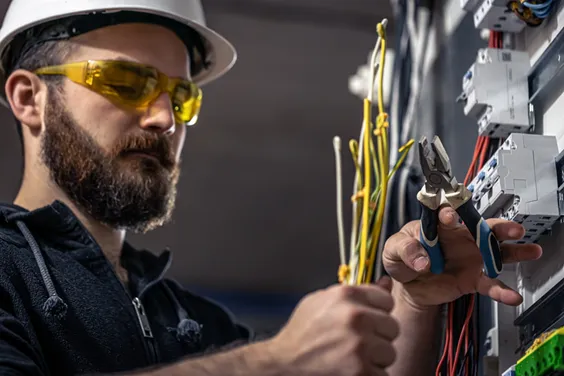
Expanding your living space? That’s exciting! A new home addition or remodel is a great way to bring up your property’s value. But let’s be honest… you’re probably unsure of the electrical work required. That’s fine. We’ve got you covered.
Cutting corners can lead to frustrating problems down the line. So, this guide will walk you through the key electrical considerations for your project, helping you make informed decisions and ensuring your new space is powered perfectly.
Assessing Your Electrical Needs: More Than Just Outlets
Here’s a step everyone forgets until it’s too late: before you even run a single new wire, you need a professional assessment of your existing electrical system. Why? Your current panel might already be working at capacity. An electrician will determine if it can handle the new load or if you need an upgrade.
Some houses have a 100-amp service that simply won’t cut it for a major addition. You might need to upgrade to a 200-amp or install an extra subpanel to avoid overloading the system.
Planning Circuits for How You Really Live
Every room has different needs. To cut it short:
- Bedrooms require AFCI (Arc-Fault Circuit Interrupter) protection. These breakers detect dangerous electrical arcs and shut off before a fire can start.
- Kitchens and Bathrooms need GFCI (Ground-Fault Circuit Interrupter) protection on outlets. These cut power instantly if they sense unusual electric flow.
Thinking Ahead: Future-Proofing Your Wiring
The best wiring plans look years down the road. A little foresight now pays for itself later. Talk with your electrician about:
- Dedicated circuits for potential future appliances, such as a wine fridge, a workshop dust collector, or a heated bathroom floor.
- Empty conduits run behind walls. This is a cheap and easy way to ensure you can pull low-voltage wiring for networking, security systems, or whatever tech comes next without tearing into drywall.
- Pre-wiring for an electric vehicle charging station. With EVs becoming more common, having the infrastructure ready is a huge selling point.
Budgeting Smartly for Your Electrical Work
Let’s talk numbers. Electrical costs can feel like a black box, but they don’t have to be. Here’s a basic breakdown of what to expect:
| Factor | What to Expect |
| Square Footage | You’re generally looking at between $4 to $9 per square foot for new construction wiring. |
| New Circuits | Each new circuit can cost between $150 and $300, depending on complexity. |
| Panel Upgrade | Upgrading from 100A to 200A service is a common need and typically runs between $1,400 and $2,800. |
| Wall Accessibility | If the electrician has to fish wires through finished walls, the labor time, and cost, goes up. |
How to Keep Costs Reasonable
You can be smart with your budget without compromising on safety.
- Plan your layout meticulously. Moving an outlet after the drywall is up is way more expensive than deciding its perfect spot beforehand.
- Bundle your projects. If you’re also updating other home electrical systems, doing it all at once is more efficient.
- Phase your wants. You can have your electrician install the necessary wiring and boxes for future pendant lights or a ceiling fan, then install the fixtures themselves later.
The Real Return on Investment
Good electrical work isn’t an expense; it’s an investment. It pays you back by:
- Increasing your home’s resale value instantly with up to code, modern systems.
- Saving on energy bills through efficient lighting and appliance circuits.
- Preventing nightmare scenarios like fire or damage from power surges that could cost you everything.
Making Your Home Smarter and More Efficient
Pre-Wiring: The Ultimate Head Start
The smartest thing you can do for future technology is to install empty conduits (smurf tubes) to key locations. This lets you pull new cables for networking, security cameras, or surround sound years from now without any drywall damage. It’s a small cost today for massive flexibility tomorrow.
Energy Management
Thinking about solar? Even if it’s years away, having your electrician make your addition “solar ready” with a conduit run to the attic and space reserved in your panel is a brilliant move. Similarly, wiring for a potential home battery backup system or for an energy monitoring system can put you in control of your power usage.
Your Most Important Decision: Choosing an Electrician
This is the part that matters most. The right electrician makes the process smooth and safe; the wrong one can create a money pit of problems.
What to Look For
Never, ever hire an unlicensed electrician. Always verify:
- A current state and local license.
- A strong reputation backed by online reviews and testimonials.
- Full insurance, including liability and workers’ compensation. This protects you if anything goes wrong.
The Campbell Electric Difference
For homeowners in Texas, finding a local expert who understands both the NEC and the specific demands of our environment is key. The team at Campbell Electric, a leading Electrical Company TX, brings that local expertise.
A proper consultation with us gives you a clear plan and the confidence that your project is in expert hands. Contact us today!
